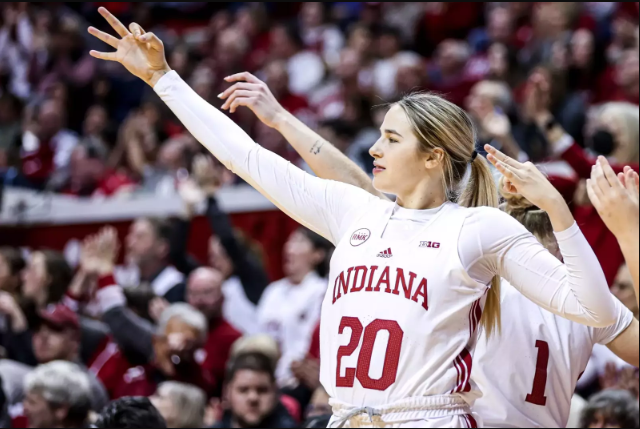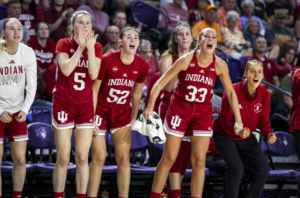
Is Indiana Women’s Basketball Better Than Ohio State?

In the world of college basketball, the rivalry between Indiana and Ohio State transcends mere statistics and individual performances. As both teams gear up for another competitive season in the Big Ten, the question arises: Is Indiana Women’s Basketball better than Ohio State? In this analysis, we will dive into a detailed comparison across nine critical categories that influence a team’s success on the court. From point guard play to rebounding, we will dissect how these two programs stack up against each other.
First and foremost, point guard play is crucial in establishing a team’s rhythm and facilitating offense. Ohio State’s point guard situation is markedly different this season. With Jacy Sheldon and Celeste Taylor having graduated, the Buckeyes have turned to Chance Gray, a transfer from Oregon. Gray averaged 13.9 points and 3 assists per game last season, showcasing her scoring ability. However, when compared to Indiana’s Chloe Moore-McNeil, who averaged 10.2 points and 5 assists per game, the statistics tell a slightly different story. While Moore-McNeil may not score as much, her ability to distribute the ball and her superior three-point shooting (along with better underlying defensive stats) give her the edge. Therefore, in the category of point guard play, Indiana takes the lead.
When we shift our focus to free throw shooting, Ohio State has some solid numbers but faces challenges with consistency. Among their returning starters, only Taylor Thierry shot better than 70% from the line, hitting 75.7%. However, Chance Gray, who transfers in, had an impressive free throw percentage of 81.1% at Oregon. On the other hand, Indiana boasts a group of capable free throw shooters: Shay Ciezki (90.2%), Sydney Parrish (79.2%), and Moore-McNeil (76.1%) all exceed Ohio State’s averages. While Ohio State has reserves who perform well at the line, Indiana’s starters take the edge in overall effectiveness. Thus, Indiana claims this category as well.
Inside scoring is another critical area where both teams have their strengths. The Buckeyes lost key contributor Rebeka Mikulsikova to graduation but return forward Cotie McMahon, who averaged 14.4 points per game. Ohio State has also brought in Kentucky transfer Ajae Petty, who added 14.2 points per game for the Wildcats. Both players shot an impressive 50% from the field last season, making them a formidable frontcourt duo. Indiana, meanwhile, is looking to integrate new players in their frontcourt, making it challenging to predict their scoring efficiency. Given Ohio State’s proven inside scoring options, this category leans in their favor.
Next, we analyze perimeter shooting, a vital aspect of modern basketball. Indiana boasts an impressive shooting roster, led by Taylor Thierry, who shot an exceptional 44.7% from three-point range last season. Other key contributors like Yarden Garzon (42.2%), Moore-McNeil (40.9%), and Parrish (40%) further strengthen Indiana’s perimeter attack. In contrast, Ohio State has Gray and Greene as their main perimeter threats, with Gray shooting 33.7% and Greene at 34.5%. The disparity in shooting percentages indicates that Indiana holds a clear advantage in this category, allowing them to stretch defenses and create scoring opportunities.
Rebounding is another crucial factor in determining which team has the upper hand. Ohio State’s frontcourt, with the combination of Petty and McMahon, presents a tough challenge on the glass. Petty averaged an impressive 10.6 rebounds per game at Kentucky, and McMahon added 6.3 rebounds per game. Together, they form a powerful rebounding duo that can control the paint and create second-chance opportunities. Conversely, Indiana’s rebounding prowess remains to be seen as they work in new frontcourt players. Given the established performance of Ohio State’s bigs, this category is rightfully awarded to the Buckeyes.
When it comes to perimeter defense, both teams have had their standout players, but Ohio State lost two key contributors to graduation. Sheldon and Taylor were instrumental in the Buckeyes’ defensive schemes, earning spots on the All-Big Ten defensive teams. Although Taylor Thierry is a strong defender, Indiana’s Moore-McNeil, Parrish, and Lexus Bargesser all bring strong defensive capabilities. With multiple plus-defenders, Indiana earns the edge in this crucial category.
The category of rim protection is vital in determining a team’s overall defensive effectiveness. Neither team boasts a dominant shot-blocker, which makes this assessment more complicated. While McMahon has solid underlying defensive metrics, Petty struggled with defensive stats during her time at Kentucky. On the other hand, Indiana’s Lilly Meister and Karoline Striplin have promising advanced defensive numbers, though they haven’t had the same starting experience as McMahon and Petty. This category is a close call, but the experience of the Buckeyes gets them the nod here.
In evaluating the proven Power Five talent on each roster, we look at players who averaged 25 minutes or more at their current or previous Power Five schools. Both teams present strong cases: Indiana’s Ciezki, Garzon, Moore-McNeil, and Parrish all meet the criteria, while Ohio State counters with Gray, McMahon, Petty, and Thierry. With both teams having four players that fit this mold, it becomes a tie, but the presence of Indiana’s Bargesser, who averaged 21.6 minutes, tips the scale in their favor.
Finally, we delve into intangibles, an often overlooked but critical aspect of team dynamics. Ohio State has a talented incoming freshman class, including guard Jaloni Cambridge, a McDonald’s All-American and top-five recruit. The Buckeyes also welcome Ella Hobbs and Ava Watson, both top 100 recruits, adding depth and talent to the roster. With head coach Kevin McGuff’s proven ability to develop young talent—having guided McMahon to be the Big Ten Freshman of the Year in 2023—Ohio State appears well-equipped for future success. Therefore, in the realm of intangibles, Ohio State holds the advantage.
After assessing each category, the final tally reveals that Ohio State narrowly wins this comparison 5-4, with the categories of free throw shooting and interior defense being particularly contentious. This outcome aligns with the Big Ten preseason poll, where Ohio State was projected to finish third and Indiana fifth. Both teams possess significant talent and should engage in a competitive battle as the season unfolds.
However, the rivalry between Indiana and Ohio State women’s basketball is one steeped in tradition and competitive spirit. As both teams prepare for a season filled with challenges and opportunities, their performances will determine their standings not just in the Big Ten but also on the national stage. Each category analyzed offers insight into their respective strengths and weaknesses, and as the season progresses, fans will eagerly anticipate how these dynamics play out on the court. Regardless of the outcome of this analysis, one thing is clear: both Indiana and Ohio State are poised to be significant players in the landscape of women’s college basketball, and their rivalry will continue to captivate fans for years to come.

Leave a Reply